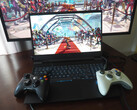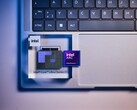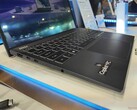Laptops featuring the latest Intel Lunar Lake APUs are finally on the market. Initial impressions of the new Lunar Lake Core Ultra 200V chips are quite positive, particularly when it comes to the single-core performance, power efficiency, and the Xe2 Arc 140v iGPU.
In our Lunar Lake CPU analysis, we mentioned that the new Lion Cove P-cores afford the Core Ultra 7 258V strong single-core performance, beating the Meteor Lake Core Ultra 7 155H by a massive 18% and Strix Point Ryzen AI HX 370 by 6%. This lead is accompanied by impressive single-threaded efficiency.
The same is true for the Arc Graphics 140V iGPU which is the fastest integrated graphics solution we’ve ever tested. The iGPU not only beats the Radeon 890M but also does so with convincing power consumption.
So, one has to wonder: What kind of gaming performance can we expect from the Lunar Lake APUs, especially when using image upscaling techniques like FSR and XeSS?
While there haven’t been a lot of tests involving image upscaling, the few results that are out there paint a good picture for Lunar Lake iGPUs when combined with FSR/XeSS.
Arc 140V shines with FSR/XeSS
Per some limited testing done by ETAPrime, the Asus Zenbook S14 with the Lunar Lake Core Ultra 7 258V ran Cyberpunk 2077 at 67 FPS average at 1080p/low with XeSS set to “Balanced”. The performance was boosted to an impressive 89 FPS when using FSR 3 Frame Generation. This is an incredible result for the Core Ultra 7 258V that was running at just 30 W. Remember, this 30 W includes the power consumed by the RAM, as Lunar Lake CPUs have built-in memory.
Moving to Forza Horizon 5, the Lunar Lake chip delivered 86 FPS on average at 1080p/medium with "Balanced" XeSS.
The Arc 140V iGPU also shined in Ghost of Tsushima, as the Core Ultra 7 258V managed average frame rates of 70 FPS at 1080p/medium with FSR 3.1 Frame Generation. Similarly, Spider-Man: Miles Morales ran at more than 70 FPS on average at 1080p with high settings.
Moreover, the Core Ultra 7 258V managed to play Red Dead Redemption 2 at 1080p with a mix of low/medium settings at around 70 FPS. This was with FSR set to "Balanced".
Finally, if you want to see more gaming samples of the Arc A140V's performance with XeSS enabled, head over our review of the Asus Zenbook S14.
Lunar Lake handheld gaming consoles are coming next year
MSI’s first foray into handheld gaming consoles, the MSI Claw, was the debut of Meteor Lake inside handhelds. Unfortunately, the Core Ultra 7 155H proved no match for the competing AMD Ryzen Z1 APUs and the Claw didn’t gain much traction. However, the company hasn’t given up. MSI is set to launch the new Claw 8 AI+ handheld gaming console with a Lunar Lake chip inside at CES 2025.
Intel’s new Xe2 graphics architecture appears to be a big step up from the first-gen Arc Alchemist, especially when it comes to the iGPU and power efficiency. Combined with better drivers and image upscaling, Lunar Lake can finally take the fight to AMD in the handheld console space.
Source(s)
ETA Prime on YouTube, Teaser image: Intel, MSI, edited

















